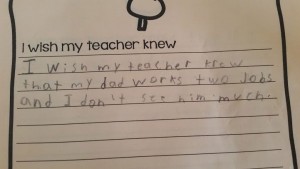According to Jean Kilbourne in her TED Talk The Dangerous Ways Ads See Women “Advertising has become much more widespread, powerful, and sophisticated than ever before”.
Advertisements are everywhere in our society today. There are even advertisements in the games people play on their phones and in video games. It is impossible to free yourself from the impeding stereotypes from these harmful ads. When women see these ads it is incredibly difficult to not feel bad about yourself for not looking a certain way.
In her TED Talk Kilbourne also said that “Brad Pitt and supermodel Linda Evangelista are both about the same age and each one are seen in an ad for Chanel, but he gets to look like a human being and she’s transformed into a cartoon”.
One limitation to this argument is that men are photo shopped in the media as well. However, when men are photo shopped it is to make them appear bigger. When women are photo shopped they are completely transformed. They are made to be smaller and flawless in every way; whether that be their skin does not have pores or they are so skinny that their head appears to be bigger than their hips. While it is dangerous for the media to photo shop both men and women it is done more often to women. These ridiculous expectations in the media are also presented more often to women than they are to men.
Kilbourne makes another point in her TED Talk that “Our girls are getting the message today so young that they have to be incredibly thin and beautiful and hot and sexy and that they are going to fail”
It is incredibly harmful when young girls are exposed to these stereotypes that are perpetuated by the media because it is telling them at a young age that they will never be good enough or pretty enough… unless they buy (insert useless product). These companies are taking advantage of the insecurities of young women and using them to make a profit. These companies are telling these women that they need this product or else they will not hold up to society’s standard of beautiful. This can cause even the most intelligent and self-confident woman to think twice about their self worth. It is easy to say “its just a sexist commercial I’m perfect the way I am” but it is incredibly difficult to maintain this thought process when everywhere you look the media is telling you you’re not good enough.
According to Lauren Rosewarne in her article Pinups in Public Space. Sexist Outdoor Advertising as Sexual Harassment, “Despite feminist concerns about the use of women in advertising fervent since the 1960s (Friedan, 1963), one need only look at billboards on any given thoroughfare to ascertain that very little headway has been made to prevent sexist advertising” (314).
It is important to understand that our society is becoming more self-aware of its sexist nature. However, as you drive down a highway you will still see countless advertisements on billboards that are demeaning towards women. Or as you play your video game you will notice the women are hardly wearing any clothing at all. It is not enough to simply recognize that there is a problem. We need to work together and figure out an effective way to combat this issue.
Within the article Images of Women In Online Advertisements of Global Products: Does Sexism Exist? it is stated that “Research has indicated that advertising in these media has rendered distorted body image ideals as valid and acceptable, contributing to gender inequality” (102).
These types of advertisements is normalizing harmful body expectations. It is also causing men to have unrealistic expectations for women. If all they see are flawless women in the media it can cause them to hold women to these ridiculous beauty standards. This is particularly true with young heterosexual men who are beginning to take a romantic interest in women.
According to Susan and Joseph Rossi in their article Gender Differences in the Perception of Women in Magazine Advertising, “Research published in the advertising and marketing literature suggests that a high degree of sexism toward women exists in magazine and television advertising; that is, women tend to be portrayed either in a degrading or demeaning fashion or in sex-role stereotypic behaviors” (1033).
Not only is the media providing women with unrealistic beauty expectations, but they are also demeaning. Women are often hypersexualized and reduced to nothing but a pair of breasts. For example, the images below show model Kate Upton eating a burger. The commercial was for a new spicy burger and it shows her wearing revealing clothing while eating the burger. They then show her undressing in her car because the burger is “so hot”. This commercial is incredibly demeaning towards women because it is reducing this model to parts of her body. The commercial even zoomed in on only her breasts and the burger was not even visible within the shot. Commercials like these perpetuate stereotypical sexual roles for women and reduce them to only being valued for their bodies.
The issue of how women are portrayed in the media is a huge issue that relates back to education. An entire demographic that we are expected to teach is constantly told that they are not good enough. Thinking back on my time in K-12 schooling I was often distracted by my body image. I would not want to get up in front of class because I was so self conscious about my body, my hair, my make-up, what clothes I was wearing that day. I know that the “ideal image” of what women are supposed to look like that the media presents had an impact on myself and my friends in our classes due to these insecurities following us everywhere we went. It is our responsibility as educators to teach our students about these stereotypes and help them recognize that they do not have to fit within a certain mold of “womanhood”. We also have a responsibility to give them the tools they need to fight back against these stereotypes.
References
Plakoyiannaki, E., Mathioudaki, K., Dimitratos, P., & Zotos, Y. (2008). Images of Women in Online Advertisements of Global Products: Does Sexism Exist? Journal of Business Ethics,83(1), 101-112.
Rosewarne, L. (2007). Pin-ups in public space. Women’s Studies International Forum,30(4), 313-325.
Rossi, S. R., & Rossi, J. S. (1985). Gender differences in the perception of women in magazine advertising. Sex Roles,12(9-10), 1033-1039.
- (2014, May 08). The dangerous ways ads see women | Jean Kilbourne | TEDxLafayetteCollege. Retrieved May 06, 2017, from https://www.youtube.com/watch?v=Uy8yLaoWybk


